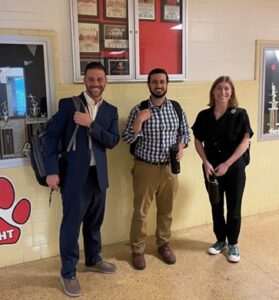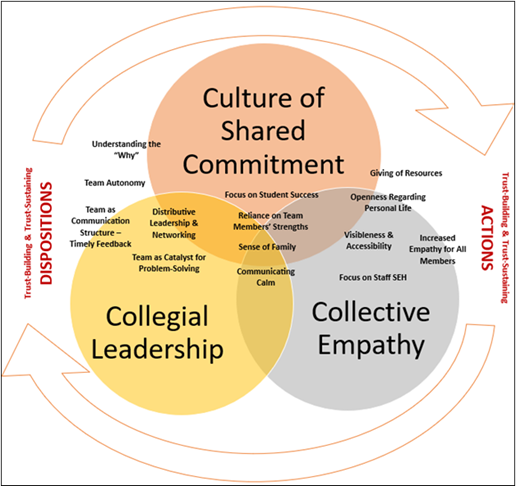Collective Empathy, Shared Commitment, and Collegial Leadership: Findings and Implications from Pandemic-Era Research
By, Dr. C. Fred Engelhardt Jr., Director of Grants and Program Development, City School District of Albany
There are certain national and global events that folks remember the precise moment when they occurred, and all of the situational context associated with that event. For P-12 educators in the United States and beyond, COVID-19 induced school closures were exactly such an event. For upstate New York educators, March 13th, 2020, will always be remembered as the day that signaled more than a year and a half of new territory in public education.
Unlike any other time in modern history, teachers and administrators had to consider health and safety, student, staff, and self and social-emotional wellness, and how to innovate around to virtual learning. This was all while the United States was steeped in political unrest and growing tensions regarding COVID-19 mandates, racial and economic disparities in the nation, and other polarizing issues. Gallop surveys indicated that during COVID-19 disruptions, trust in government and in one’s neighbor in making appropriate decisions was at an all-time low.
In 2021, as I completed my dissertation, I was honored to join NYKids’ study of six schools in upstate New York. The schools in the study were identified as “positive outlier schools” based on their comparatively better responses of staff members on a survey of job satisfaction and job-related stress during COVID-19. The study was aimed at understanding how schools weathered the storm of COVID-19 and adapted to the disruptions associated with the pandemic.

As part of this “weathering,” I was curious about qualities of relationships between teachers and school leaders, specifically principals, and sought to discover how teacher-leader relationships related to the effects of COVID-19. Previous research has demonstrated correlations between job satisfaction and high levels of leadership trust, so I felt there would be some great lessons learned around leadership-trust dynamics, especially during sustained crises.
Why Focus on Trust?
Trust, or lack of trust, during COVID-19 in P-12 education was intriguing to me as a practitioner in a district just outside of Albany, New York, I experienced teachers and school administrators working together throughout the pandemic unlike times before. Relationships were different and I understood that this was, in part, due to the stressors associated with the pandemic. Teachers’ concerns, administrators’ anxieties, and student and family challenges were apparent and, while there were negative impacts on school functions, I also noted individuals “coming together” and trusting each other to work through situations in a solutions-oriented way. Researching how relationships may have mitigated educator stress would offer considerations for future research, leadership practices, and organizational processes.
Within effective organizations, relational trust has been referred to as “connective tissue,” “lubricant,” or “social glue.” Within P-12 education, relational trust includes the “shared-ness” and collective nature of responsibility, accountability, and action which creates a strong commitment on the continued betterment of a learning community for the success of students.
A leader’s dispositions (i.e., characteristics and temperaments) and actions and their relationship to building and sustaining trust within organizations has been the focus of many research projects. Drawing on the data gathered with NYKids team members in the NYKids study, I asked the following research questions:
- How do educational leaders describe their dispositions in supporting relational trust as they led others through the COVID-19 pandemic disruptions in their schools?
- How do educational leaders describe their actions in supporting relational trust as they led others through the COVID-19 pandemic disruptions in their school?
Specific leadership dispositions and actions have been identified in the literature as trust-building and trust-sustaining. The dispositions and actions that I examined were:
| Dispositions | Actions |
| Benevolence | Collaboration |
| Competence | Communication |
| Commitment | Creating an “Open Climate” |
| Honesty & Openness |
Collective Empathy, Shared Commitment, and Collegial Leadership
The findings were intriguing. The leadership dispositions and actions mentioned above were present in the schools studied and demonstrated strong connections between teachers’ trust in leaders and trust in each other (something described as “reciprocal trust” in prior NYKids research). What was even more interesting were the adaptations that these dispositions and actions underwent during the height of the COVID-19 pandemic.
For example, teachers regularly reported how kind and caring (i.e., benevolent) leaders were during the pandemic. They mentioned the leaders’ attention to staff needs and social-emotional health. Teachers also recognized that the pandemic forced leaders to undertake new tasks and experience higher levels of stress never associated with the position before. Staff communicated a strong empathy for their leadership. Principals reciprocated this sentiment, communicating their empathy towards teachers in understanding the nuances of virtual instruction, the challenges of health and safety measures, and the personal anxieties that they felt. This led to a mutual empathy, or what I coined as a “Collective Empathy” (see Venn Diagram below).
In addition to collective empathy, two other larger themes emerged: shared commitment and collegial leadership:
Shared Commitment was demonstrated by teachers and leaders hyper-focused on student success. Adaptations in collaboration (e.g., teams and committees) and new considerations in communication methods continued to focus on student achievement regardless of the disruptions of the pandemic.
Collegial leadership stemmed from the belief that voices mattered and that the “experts are in the room” when it comes to decision making. Adaptations around shared decision-making and feedback loops were valued, though adaptations did occur through the transition to virtual committee meetings and the increase of community and staff surveys. Allowing for opportunities for input into planning, whether it was COVID reopening plans or student improvement plans, promoted a sense of shared responsibility and collective accountability.

The above conceptual map demonstrates the overlap and intersections of the various dispositional and action-based concepts that were noted in trust building and trust-sustaining leadership in my research. While dispositions and actions were “tweaked” during the pandemic, leaders in this study pointed to larger themes of a Culture of Collective Empathy, Shared Commitment, and Collegial Leadership.
Trust and Crisis
With both trust-building and trust-sustaining, a crisis can be seen as an opportunity. Winston Churchill was credited with saying, “Never let a good crisis go to waste.” This can be said for crises in P-12 schools that can provide opportunity to build and cement trust. There was a degree of flexibility and adaptation that occurred during the pandemic that promoted trust-building and trust-sustaining dispositions and actions. If rigidity in leadership practice occurs during a crisis, literature would indicate that there can be organizational decline or a fostering of distrust.
Reflecting on Promising Practices
While generalizing beyond the cases investigated must be done with caution, as a P-12 practitioner, I gleaned a number of practical “lessons learned” from this study.
The first practice that I would encourage is the creation of team structures that exercise problem-solving protocols. This idea of “team,” not only will allow for brainstorming, but also ongoing communication and collaboration and participatory decision making. And if constructed well, teams can create social emotional support for colleagues during times of crisis.
Second, and similar to this purposeful collaborative action, I would consider establishing formal and informal mentor relationships and peer partnerships. The cases indicated that during a crisis teachers felt supported by, not only their team, but by their “go-to- person” for academic support and for their own social-emotional wellness. In several of the cases, traditional teacher mentor relationships became reciprocal with veteran teachers sharing the expertise of school culture and curriculum and leaned on probationary teachers’ expertise around virtual instructional strategies.
As a last, but important, take-away from this study, I would be purposeful about building the school identity as a team or family. The feeling of “we are all in this together” creates shared responsibility and accountability towards student success and can sustain people to work together through the most difficult of times.
You can read the full study by Dr. Engelhardt Jr. here. You can learn more about Dr. Engelhardt’s work at CSDA here: https://www.albanyschools.org/news/1764035/new-grants-administrator
From NYKids – as always we welcome all your questions or feedback at nykids@albany.edu. Please follow us on Facebook, X, Instagram, and LinkedIn.
